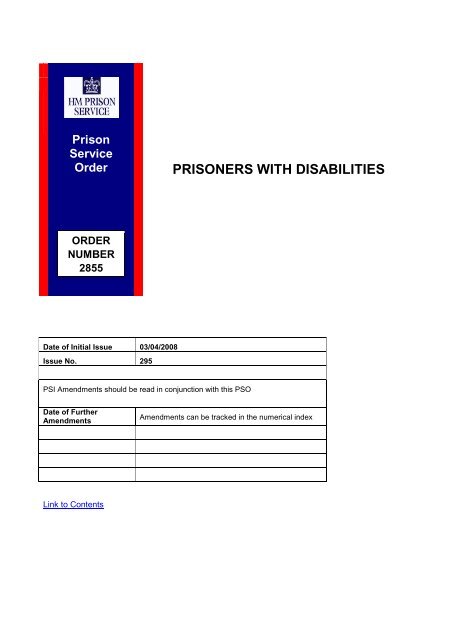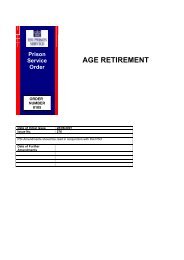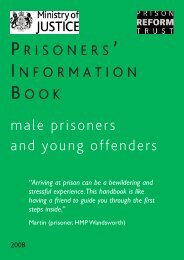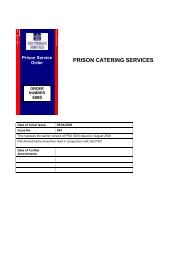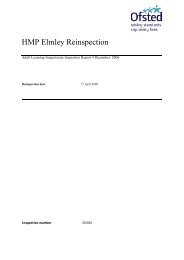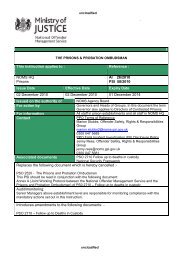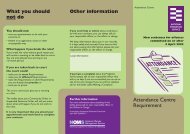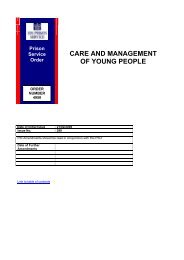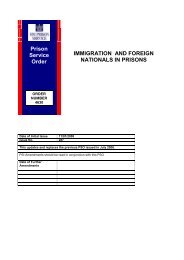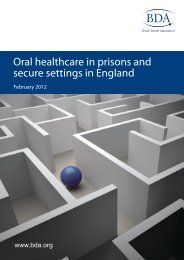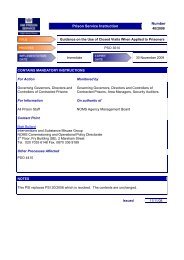PSO 2855 - Inside Time
PSO 2855 - Inside Time
PSO 2855 - Inside Time
You also want an ePaper? Increase the reach of your titles
YUMPU automatically turns print PDFs into web optimized ePapers that Google loves.
PrisonServiceOrderPRISONERS WITH DISABILITIESORDERNUMBER<strong>2855</strong>Date of Initial Issue 03/04/2008Issue No. 295PSI Amendments should be read in conjunction with this <strong>PSO</strong>Date of FurtherAmendmentsAmendments can be tracked in the numerical indexLink to Contents
<strong>PSO</strong> <strong>2855</strong> Page 1EXECUTIVE SUMMARYSTATEMENT OF PURPOSEThis <strong>PSO</strong> updates and replaces the previous <strong>PSO</strong> on the management of prisoners with physicalsensory or mental disabilities. It sets out required actions and good practice relating to all aspectsof prison life relating to prisoners with disabilities.This <strong>PSO</strong> applies to all prisoners, and it will usually be best to assume that a prisoner could have adisability rather than not.References to Governors should be taken to include Directors of Contracted Prisons.DESIRED OUTCOMEThat all managers and staff understand and comply with the law as set out in the DisabilityDiscrimination Act 1995 and the Disability Discrimination Act 2005.The DDA 1995 applies to service providers (including the Prison Service for example in itsprovision of offending behaviour, skills and employment, drug treatment programmes etc andrequires access (both physical and in the broadest sense) to services to be ensured and forreasonable adjustments to be made.The DDA 2005 goes much further, along the same lines as legislation on race, introducing theDisability Equality Duty that came into force in October 2006 which places specific duties onpublic bodies to:look at all policies which impact upon prisoners, not just to respond reactively to prisoners‟individual needs;not to discriminate against people with disabilities by introducing a new requirement topromote equality of opportunity: this will require statistics to be collected and monitored;eliminate harassment and to promote positive attitudes towards people with disabilitiesMANDATORY ACTIONSThis <strong>PSO</strong> contains eight mandatory actions:Governors Managers and staff must comply with the requirements set out in the DDA;Governors and Managers must ensure that procedures exist in prisons for prisoners to beable to disclose disability both on reception and subsequently and this must be recorded onLIDs; (or its replacement when available)Issue No. 295 Issue date 3/04/08
<strong>PSO</strong> <strong>2855</strong> Page 2Governors must ensure that a local policy is in place to ensure that prisoners withdisabilities are treated in accordance with PS policy and this local policy must include howequality of opportunity for disabled prisoners will be promoted;The Governor must nominate as Disability Liaison officer a suitable member of staff whohas regular contact with prisoners and is given sufficient time to act as a contact point toreceive information on policy issues and good practice, act as an adviser on disabilityissues and ensuring that disabled prisoners’ needs are met.Governors and policy leads must ensure that policies are impact assessed for disability andthat any adverse impact on disabled prisoners is addressed.The Prison will ensure that the escort contractor is advised, in advance, of any prisonerrequired at court that has a disability. The escort contractor will be provided with the detailsof the disability and the needs of the prisoner.The prison will ensure that where a disabled prisoner is required at court, the Clerk ofCourt will be advised of the disability and needs of the prisoner who is to be produced.Governors must ensure that an action plan is completed for the establishment whichidentifies any barriers to equality of opportunity for disabled prisoners;RESOURCE IMPLICATIONSThere are resource implications arising from the Disability Discrimination Acts. However there isan element which can only be quantified in prisons under reasonable adjustments which are therequired response to individual prisoners‟ needs. There will also be resource implications indrawing up and maintaining the establishment action plan as required by legislation.IMPLEMENTATION DATE: 21 April 2008(signed)Michael SpurrDeputy Director GeneralArea/Operational ManagerFurther advice or information on this <strong>PSO</strong> or the systems contained with in it can be soughtfrom:Carrie Cannings, Marion StubbsSafer Custody & Offender Policy Group0207 035 1543, 1575Issue No. 295 Issue date 3/04/08
<strong>PSO</strong> <strong>2855</strong> Page 3<strong>PSO</strong> <strong>2855</strong>: PRISONERS WITH DISABILITIESCONTENTS1. Introduction2. Disability Discrimination Act 1995 As Amended by the Disability Discrimination Act 20053. Prison Service PolicyLegal Obligations4. Actions arising from the Ministry of Justice Disability Equality SchemeDrawing up an establishment action planImpact assessmentsLocal policiesNational policies5. Management of Disability in establishmentsThe role of the Disability Liaison OfficerRecording disability on LIDS6. The Prisoner ExperienceReceptionInductionNormal location- Work- Education- PE- Chaplaincy- Visits- Communication- Adjudications- Request/Complaints- HealthcareTransfersResettlementReleaseEscorting Issues7. Older Prisoners8. Reasonable adjustmentIssue No. 295 Issue date 3/04/08
<strong>PSO</strong> <strong>2855</strong> Page 4ANNEXESABCDEFGHIJSample local policy documentReception Disability Questionnaire (Sample form)Different disabilities and possible adjustmentsGood Practice generallyDraft establishment action planEntering Disability Codes on LIDS – User GuideAccess to external agencies and information.Disability Liaison Officer Draft Job DescriptionFull Impact Assessment TemplateGuidance for Impact AssessmentIssue No. 295 Issue date 3/04/08
<strong>PSO</strong> <strong>2855</strong> Page 5INTRODUCTIONPurpose of the <strong>PSO</strong>1.1 This <strong>PSO</strong> sets out Governors‟ responsibilities under the Disability Discrimination Act 1995(DDA), which incorporates amendments made in the Disability Discrimination Act 2005towards prisoners with disabilities. The Order provides instructions and guidance on PrisonService policy and the requirements introduced by the final stages of the DDA, which cameinto force in 2005 and 2006. For a summary of these requirements, see paragraph 2.10below.1.2 Under the DDA, disability is self declared and there is no need for certification orregistration of disability, whether in prison or the community.1.3 It is best practice to explain to prisoners that, if they choose not to declare any needs theyhave related to disability, these needs would not be catered for. Should they declare adisability, Healthcare officers and the Disability Liaison Officer (DLO) will need to be madeaware to enable them to verify the level of disability, consider the prisoner‟s needs andarrange for those needs to be met. This will enable the Prison Service to fulfil its legalobligations under the Act.1.4 Mandatory actions listed in this <strong>PSO</strong> arise from the requirements and obligations set out inthe DDA, and with the exception of Action Plans and Impact Assessments, were present inthe previous <strong>PSO</strong>s. This <strong>PSO</strong> also includes recommendations to encourage thedevelopment of good practice towards prisoners with disabilities, and guidance on areasthat establishments may wish to consider when drawing up their establishment Action Plan.1.5 This <strong>PSO</strong> introduces the DDA requirement that all new and revised National Policies areto be impact assessed using the Disability Impact Assessment form at Annex I. Existingpolicies will need to be assessed when it is considered that they might have a significantand disproportionate impact on prisoners with disabilities.1.6 Local Policies, new and revised, will need to be assessed using the template at Annex I.Any impact assessment of existing policies that the establishment feels necessary shouldbe included in the Establishment Action Plan, with priority given to those policies,processes and functions relating to access to work, PE and education, interventions andaccommodation.1.7 It is Prison Service policy, in line with developing legislation, that disabled prisoners are notIssue No. 295 Issue date 3/04/08
<strong>PSO</strong> <strong>2855</strong> Page 6discriminated against in any aspect of prison life and that equality of opportunity inaccessing all parts of prison life, and in particular to address their offending behaviour andbe resettled is offered to all prisoners.1.8 One of the requirements introduced by the final stage of the legislation is the introduction ofdisability equality schemes. The Prison Service is covered by the Ministry of JusticeDisability Equality Scheme, and therefore there is no requirement for a separate PrisonService Scheme. The legislation also introduces the requirement for Action Plans whichare set out as new Mandatory action in this <strong>PSO</strong>:- Governors must ensure that an action plan is completed for the establishmentwhich identifies barriers to equality of opportunity for disabled prisoners1.9 Throughout the Order references to Governors apply equally to the Directors of contractedprisons.Prison Service Standard1.10 The Standard for Disabled Prisoners sets the quality of provision which must be in place.This states that:The Prison Service ensures that all prisoners are able, with reasonableadjustment, to participate equally in all aspects of prison life withoutdiscrimination.Access to Order1.11 It is important that this Order is readily available to all staff as the duties not to discriminateand to promote equality of opportunity for prisoners with disabilities is required of the wholeof the prison estate. It should also be made available to prisoners, in a format that is ableto be understood, i.e. large format text, audio etc and in other languages where appropriateto reflect the local prison population.Issue No. 295 Issue date 3/04/08
<strong>PSO</strong> <strong>2855</strong> Page 7CHAPTER 2THE DISABILITY DISCRIMINATION ACT 1995 (DDA) as Amended by the DisabilityDiscrimination Act 2005Definition of disability2.1 Under the DDA, disability is self declared and there is no need for any certification orregistration of disability. The DDA defines disability as:“A person who has a physical, sensory or mental impairment which has a longterm and substantial effect on their ability to carry out normal day to dayactivities”.2.2 “Impairment” covers physical or mental impairments and includes sensoryimpairments, such as those affecting sight or hearing. It includes:DiabetesDyslexiaAutismDeafnessAsthmaArthritisDepressionSevere disfigurementand many others, both visible and invisible.2.3 A “physical impairment” may be the result of illness or accident and could include issuesaround mobility or flexibility, limited ability to manipulate objects, or restrictions on activityand energy levels, The disability may not be apparent to an observer and may haveimplications that are not immediately obvious.2.4 “Mental Impairment” covers a wide range of impairments relating to mental functioningincluding learning disabilities/ difficulties and mental illness. It can include impairment as aresult of drug or substance abuse (but not the addiction itself).2.5 “Sensory impairment” includes partial and full deafness, hearing disturbances includingsevere tinnitus, eyesight problems such as partial and full blindness, restricted sight, (butIssue No. 295 Issue date 3/04/08
<strong>PSO</strong> <strong>2855</strong> Page 8not poor eyesight which is corrected to a satisfactory level by glasses or contact lenses),numbness and loss of feeling which affects the sense of touch or ability to feel pain.2.6 “Substantial adverse effect” is not defined by the Act other than that it is more than a minoror trivial effect. The requirement that an effect must be substantial reflects the generalunderstanding of disability as a limitation going beyond the normal differences in abilitywhich exist among people.2.7 “Long term” means 12 months or over.2.8 It is very important to be aware that someone who has had a disability which falls within thedefinition given above is protected by the DDA from discrimination even if they haverecovered, or where the condition is controlled by medication. This would cover, forexample, someone who has had an episode of mental illness, or someone who hassuffered from a physical injury which lasted for a certain period.2.9 If an impairment has had a substantial effect on normal day-to-day activities but that effectceases, legally it is treated as continuing if it is likely to recur. For example someone whohas arthritis, continues to be protected by the DDA, even during periods of remission2.10 Certain conditions are not regarded as impairments under the DDA:addiction to or dependency on alcohol, nicotine, or any other substance (other thanas a result of the substance being medically prescribed);seasonal allergic rhinitis (e.g. hayfever), except where it aggravates the effect ofanother condition;tendency to set fires;tendency to steal;tendency to physical or sexual abuse of other persons;exhibitionism;voyeurism;tattoos and non-medical body piercing.2.11 Information on various disabilities can be found in back issues of <strong>Inside</strong> Disability availablein the Information Store on the Intranet, or by contacting OPRU on 0207 035 1575.NEW REQUIREMENTS INTRODUCED BY THE DDA2.12 From December 2006, public authorities were required to publish a Disability EqualityScheme (DES) setting out how they will implement the Disability Equality Duty. The PrisonIssue No. 295 Issue date 3/04/08
<strong>PSO</strong> <strong>2855</strong> Page 9Service‟s DES was originally published as an associate scheme within the overarchingHome Office Disability Equality Scheme. As a result of the Prison Service‟s move from theHome Office to the Ministry of Justice, the new Ministry of Justice Disability EqualityScheme will include a section covering Prisoners.2.13 This duty is not necessarily about changes to buildings or adjustments for individuals, it‟s allabout including equality for disabled people in practical and demonstrable ways. Thismeans considering disabled people and disability equality in all aspects of prison life, ratherthan simply focusing on individualised responses to specific disabled prisoners.2.14 The Disability Equality Duty is a new way for public authorities to tackle disabilitydiscrimination in a practical way by introducing policies that actively promote opportunitiesand so prevent discrimination taking place. Since the launch of the Disability Equality Dutyin December 2006 the Disability Rights Commission (DRC) has worked to actively enforcethe new duty on public sector bodies.2.15 Under the Disability Equality Duty (DED) the DRC, and its successor the Commission forEquality and Human Rights (CEHR), can take legal action against public authorities thathave failed to carry out their responsibilities under the DED, by issuing compliance notices.2.16 Along with individual disabled people they can also challenge a public authority‟s failure tomeet the general duty by seeking a judicial review in the High Court, or Court of Session inScotland.THE DISABILITY DISCRIMINATION ACT 2005 (DDA)2.17 The main differences between the requirements of the DDA 1995 and the DDA 2005 are:The DDA 2005 specifically applies to public bodies like the Prison Service (underthe DDA 1995 this was not clear);There is a requirement to look at all the policies which impact upon prisoners, notjust to respond to prisoners‟ individual needs.There is a much stronger requirement not to discriminate against people withdisabilities by introducing a new requirement to promote equality of opportunity: thisrequires statistics to be collected and monitored;A need to eliminate harassment and to promote positive attitudes towards peopleIssue No. 295 Issue date 3/04/08
<strong>PSO</strong> <strong>2855</strong> Page 10with disabilities, including hidden disabilities;Progressive conditions like cancer, HIV and multiple sclerosis are covered from firstdiagnosis (up to now this has been from first onset of symptoms).DUTY UNDER THE DDA TO MAKE REASONABLE ADJUSTMENTS2.18 The Prison Service has a duty placed upon it by the DDA to make reasonable adjustments.“Reasonable adjustment” is not defined in the DDA, but will be interpreted by the courts.Reasonableness varies according to:The type of organisation and its business;The nature of the organisation and its size and resources;The effect of the disability on the individual.See Chapter 8 entitled „Reasonable adjustments‟REQUIREMENTS PLACED UPON THE PRISON SERVICE BY THE DDA2.19 Governors Managers and staff must comply with the requirements set out in the DDA.Governors and Managers must ensure that procedures exist in prisons for prisonersto be able to disclose disability both on reception and subsequently and this must berecorded on LIDs; (or its replacement when available). This must be completed onreception/induction or as appropriate thereafter (for example if disability occurs or isdiagnosed in prison).Issue No. 295 Issue date 3/04/08
<strong>PSO</strong> <strong>2855</strong> Page 11CHAPTER 3PRISON SERVICE POLICYPrison Service Policy Statement3.1 HMPS will treat all prisoners with disabilities with decency and without discrimination andwill offer them equality of opportunity in all aspects of prison life. Prisoners with disabilitieswill be offered equal opportunity to address their offending behaviour and will be treated ina safe and secure environment.3.2 HMPS will promote equality of opportunity for prisoners with disabilities.Local Statements of policy3.3 Governors must ensure that a local policy is in place to ensure that prisoners withdisabilities are treated in accordance with PS policy and this local policy must include howequality of opportunity for disabled prisoners will be promoted.3.4 A sample local policy is at Annex A. Governors may wish to incorporate disability into awider diversity policy which includes all aspects of diversity. Local statements of policy ondisability must be clearly displayed in the Reception area, First Night Centre, Induction wingand other prominent locations, including details of who to contact about disability issues,and kept up to date.Local contact point3.5 The Governor must nominate as Disability Liaison officer a suitable member of staff whohas regular contact with prisoners and is given sufficient time to act as a contact point toreceive information on policy issues and good practice and act as an adviser on disabilityissues in ensuring that disabled prisoners needs are met.3.6 Where necessary, and there are sufficiently large numbers of prisoners, Governors maywish to consider having a disabled prisoners committee with prisoner representatives; thiscan help to ensure the needs of disabled prisoners are addressed. In addition, wheregroups of prisoners with similar needs have been identified, focussed activities could beorganised. It is good practice to involve outside groups – see list at Annex I for contacts.The work of the DLO should be covered during absences to ensure that, for example,applications are still opened and prisoners do not have to wait until the designated officerreturns from leave to have issues dealt with.Issue No. 295 Issue date 3/04/08
<strong>PSO</strong> <strong>2855</strong> Page 12CHAPTER 4The Ministry of Justice Disability Equality Scheme4.1 The Prison Service has a staff Single Equality Scheme, which includes Disability, Gender,and Race.4.2 The Prison Service has contributed towards the Ministry of Justice Disability EqualityScheme to cover prisoner issues. The Disability Equality Scheme includes the requirementfor each establishment to draw up an Action Plan to address issues affecting the access ofdisabled prisoners to facilities and regime activities as required by the DDA. Thisrequirement is introduced as a Mandatory Requirement in this <strong>PSO</strong> along with the DisabilityImpact Assessment of all policies, both local and national.Drawing up an establishment action plan4.3 Access audits have been in place for some time and each establishment should already bedoing regular access audits of the prison layout and fabric. Those areas highlighted by theaccess audits, impact assessments and raised by staff and prisoners as preventing orrestricting disabled prisoners‟ access to the regime and prison facilities, should form thebasis of the establishment Action Plan. A sample Action Plan is at Annex E. The planshould also set out what actions the prison would need to take to tackle the problem, orwhat changes to procedures could be put in place to minimise the discrimination. If actionis planned within the life of the Action Plan, usually three years, this should also be setdown, together with milestones and review dates.4.4 The Action Plan should highlight areas such as improvements to the fabric of the prison,even where responsibility lies with NOMS. The prison action in such a case would be toraise the required improvements with NOMS, and follow up the request. The same appliesfor any thing which is an obstacle to a disabled prisoner‟s involvement in the life of theestablishment where the power to rectify or address the problem lies outside the control ofthe Governor.4.5 Any significant problem should be escalated to the Area Manager if it is not resolved withina reasonable period of time.4.6 The Action Plan does not just cover physical barriers and should include reviews of andchanges to local policies and practices, issues such as translation of information intoaccessible formats, and any local issue which may cause difficulties for or excludeIssue No. 295 Issue date 3/04/08
<strong>PSO</strong> <strong>2855</strong> Page 13prisoners with disabilities from the regime, activities, or any other aspect of life in theestablishment. Issues raised as a result of prisoner complaints or by prisoner groupsshould be assessed and included in the Action Plan. The impact assessment of localpolicies (see below) should also be included in the Action Plan.4.7 The plan is a living document and should be updated as issues arise or actions arecompleted. The actions should also be reviewed at the beginning of each financial year toensure that the timescales etc are realistic and achievable.Impact Assessment of Policies.4.8 The initial Impact assessment in respect of disability has been incorporated into a singleinitial impact assessment tool which will be launched separately from this <strong>PSO</strong>. Onceissued, it should be used to assess both National and Local policies to determine whether afull impact assessment is required. Initially it should be used for new and revised policies.However, existing policies will need to be assessed if they are likely to have a particularimpact on prisoners with disabilities.4.9 The Full Impact Assessment form and guidance on completion are attached at Annex I & J.This should be completed where the initial impact assessment indicates that there is scopefor an impact on prisoners with disabilities.Mandatory Action : Governors and policy leads must ensure that policies are impactassessed for disability and that any adverse impact on disabled prisoners isaddressed4.10 It is intended to move to a generic full impact assessment to cover all aspects of diversity.This is currently under discussion, and until the single assessment tool is issued it will benecessary to complete a separate disability impact assessment.Local Policies4.11 Governors should ensure that new and revised Policies, Practices and Functions areimpact assessed for disability and that any areas highlighted which adversely affectdisabled prisoners are revised to address the inequality.4.12 It is appreciated that impact assessing the whole range of policies and functions is amammoth task and will need to done over a period of time. Existing functions which have aIssue No. 295 Issue date 3/04/08
<strong>PSO</strong> <strong>2855</strong> Page 14particular significance for prisoners with disabilities should be given priority as these are theareas which are most likely to need attention, and raise issues for particular prisoners.Areas which should be given priority are access to work, PE, education and interventions,and allocation to accommodation.4.13 A copy of the impact assessment should be retained. Governors should be aware thatbeing able to demonstrate that a policy has been impact assessed and the issues raisedaddressed by the establishment to the best of its ability, will help if that policy is thenchallenged by a prisoner under the DDA. Quality assurance should be done at anestablishment level.4.14 Areas which need attention highlighted by an Impact Assessment should be included in theestablishment Action Plan. As should the programme of impact assessment for existingpolicies, practices or functions.National Policies4.15 National Policies which are indicated on the initial impact assessment as relevant todisability should also be assessed using the Disability Impact Assessment form. Evidenceof Impact Assessment should be included with the business case for new and revisedpolicies. Other policies should be impact assessed if it is felt they might have a significantimpact on disabled prisoners, if the policy is not due for review within a reasonable period.Advice on prisoner disability issues can be obtained from Safer Custody & Offender PolicyRights Unit who are happy to be consulted during the policy development process.Issue No. 295 Issue date 3/04/08
<strong>PSO</strong> <strong>2855</strong> Page 15CHAPTER 5The Management of Disability within EstablishmentsThe role of the Disability Liaison Officer (DLO)5.1 The role of the Disability Liaison Officer (DLO) is principally to act as a source ofinformation and advice within the establishment on issues of disability affecting prisoners.They are not expected to be experts, but rather to know where to obtain information oradvice when needed. Where the Governor expands the role to cover staff disability issuesas well, the DLO needs to be resourced to cover the additional work. The DLO should beproviding advice to managers and staff, and is not responsible for undertaking all disabilityrelated work in the establishment. The DDA places the responsibility for ensuring thatdisabled persons do not suffer discrimination on all managers and members of staff.5.2 The Governor should ensure that the DLO (and any staff assisting in the role) have the timeand resources to fulfil their duties given the size of the establishment and the nature of thepopulation. Cover for the DLO should be in place for any significant absences to ensurethat, for example, applications made to the DLO are opened (and actioned where possible)rather than being left for the DLO‟s return from leave.5.3 These duties may include interviewing or speaking to prisoners on induction, dealing withapplications, and assisting with drawing up the establishment action plan. It should includeproviding advice to the senior management team on disability issues affecting theintegration of prisoners with disabilities into the life of the establishment. The DLO shouldbe accessible to prisoners, and it should be possible for prisoners to discuss sensitiveissues involving their disability with the DLO in private. Information confided by the prisonerto the DLO should be treated in confidence and only disclosed when strictly necessary. Forexample if the prisoner will have difficulty in the case of an emergency, or knowledge of thedisability may enable other staff to assist and manage the prisoner better.5.4 Reasonable adjustments arranged by the DLO or another member of staff, for a particularprisoner should be recorded on his/her record, both to ensure that on transfer thatinformation is made available to staff at the receiving prison, but also to document theactions taken to meet our duty under the DDA.5.5 A sample DLO job description is attached at Annex H.Issue No. 295 Issue date 3/04/08
<strong>PSO</strong> <strong>2855</strong> Page 16Recording disability on LIDS (Or its replacement)5.6 Attached at Annex F is the Guidance for inputting information on disability onto theprisoner‟s record on LIDS. In due course another system will replace LIDS and at that pointfurther guidance will be issued.5.7 It is important that the details of those prisoners who disclose a disability are recorded onLIDS. The data collected at establishments is aggregated and made available to AreaOffices and Headquarters. It will be used to respond to enquiries about our compliancewith the DDA, and though we appreciate the information is reliant on prisoners disclosing tostaff, we need to ensure that the aggregate data is as accurate as possible.5.8 The questionnaire at Annex B should be used to ask the prisoner and record his/herresponses. This should be completed during the Induction process. Establishments mightalso find it useful to extract disability data and use it to inform more general reasonableadjustments, such as the provision of information in alternative formats or the planning ofprovision for certain courses or activities to match the needs of the population.Issue No. 295 Issue date 3/04/08
<strong>PSO</strong> <strong>2855</strong> Page 17CHAPTER 6The Prisoner ExperienceReception(See <strong>PSO</strong> 0500, <strong>PSO</strong> 2700, PSI 32/05)6.1 Prisoners with disabilities need to be given the opportunity to declare their disability as earlyas possible, and at any point they choose thereafter. It is important to take into accountthat under the DDA, declaration is voluntary, and prisoners should not be labelled asdisabled who do not regard themselves as such. It is best practice to explain to prisonersthat if they choose not to declare any needs they have related to disability that these needsmight not be catered for. This does not mean that an obvious reasonable adjustment whichwould assist a prisoner should not be made because he/she does not consider themselvesto be disabled.6.2 If a prisoner is identified as being at risk of suicide and/or self harm, the ACCT CaseManagement Team will take account of all relevant facts, including disability.6.3 From November 2006, all public bodies had a legal duty to promote equality of opportunityfor prisoners with disabilities. This means that the number of disabled prisoners receivedinto prison has to be recorded and monitored. This will be based on self declaration by theprisoner. See recording Disability on LIDS, para 5.6.6.4 The form at Annex B should be used for this purpose, it may be adapted if necessary tosuit local circumstances. A copy of the completed form should be sent to the healthcareofficer to be considered as part of the healthcare screening. Link to Chapter 6 <strong>PSO</strong> 0500.Any issues relating to disability of which healthcare staff are made aware, and any adviceon the management of these issues that they can provide, should be communicated to theDLO, wing staff or other staff who would be responsible for ensuring that any necessaryreasonable adjustments are made.6.5 Governors and Senior Management Teams need to be kept advised of the numbers ofdisabled prisoners being held and also the types of disabilities.6.6 Essential information covering what happens in Reception and the First Night Centreshould be made available in a variety of formats (video, audio-tapes, pictorial etc) to helpovercome learning difficulties (Para 7.11, <strong>PSO</strong> 0500, Reception <strong>PSO</strong>) and adapted fordifferent disabilities.Issue No. 295 Issue date 3/04/08
<strong>PSO</strong> <strong>2855</strong> Page 186.7 Any special needs a prisoner has and action taken to address them needs to be recordedon the prisoner‟s F2052A. It is best practice to consult the prisoner on how they feel theirdisability affects them and to give them the opportunity to state their needs, rather thanmaking assumptions.6.8 Any form of aid to mobility (or to sensory perception) including wheelchairs, whetherspecially adapted or not, crutches, sticks etc need to be retained in possession, unlessthere is a good (and defensible) reason not to. If Reception staff are concerned that theremay be a security risk involved, a risk assessment needs to be carried out and a suitablealternative provided. If this involves the prison providing an alternative wheelchair, careneeds to be taken to ensure the prisoner is transferred safely.6.9 The searching of prisoners with disabilities, whether by rub down or a full search, needs tobe conducted at all times with dignity and decency and take full account of the prisonersdisability. Staff need to ask the prisoner what his/her needs are, explain what the searchwill involve, and what the prisoner will be asked to do. Staff need to ensure that theprisoner understands what will happen before the search begins. This may be particularlyupsetting for prisoners with an autistic spectrum disorder. If there are any doubts about theapplication of searching procedures it is good practice to consult a member of thehealthcare team. Link to (NSF Function 3, Searching People with Injuries or Disabilities).First Night Centres and Induction(See <strong>PSO</strong> 0550)6.10 Prisoners with disabilities need to have access to an induction programme adapted to meettheir needs. Good practice exists in the Assisted Advice and Access (AAA) Centre at HMPManchester where induction is targeted at addressing the needs of the most vulnerable,including those prisoners with disabilities, and factors such as the ability to understandEnglish, literacy, mental health and educational needs are taken into account whendetermining how long the prisoner will spend on the Induction Wing. Prisoners are able toreturn to the wing should they fail to cope or need further support.6.11 Where possible, information given on Induction, as well as other important information,needs to be made available in alternative formats e.g. large print, pictorial, Braille andaudio-tape. An Information Book for Disabled Prisoners has been prepared by the PrisonReform Trust in association with the Prison Service and this should be made available to allprisoners with disabilities (see Annex G for details)Issue No. 295 Issue date 3/04/08
<strong>PSO</strong> <strong>2855</strong> Page 1Sentence Planning and Offender Management(See <strong>PSO</strong> 2205)6.12 Any adjustments arising from a prisoner‟s disability need to be fed into sentence plans. It isimportant that those interventions needed to address the likelihood of reoffending areavailable to all prisoners. Sources of information and advice can be sought through specificaction and support groups some of which are listed at Annex G.Normal locationAllocation to accommodation6.13 Prisoners with disabilities need to be allocated to accommodation suitable to their needs. Itis best practice where possible not to routinely accommodate prisoners with disabilitieswithin healthcare departments, but on normal location otherwise they can miss out onaccess to all aspects of the prison regime. Support may be necessary to enable a prisonerto stay on normal location. Access to those parts of the regime identified in a prisoner‟ssentence plan is crucial.6.14 When refurbishments are being undertaken, the needs of disabled prisoners must beconsidered and accommodated. For example, this should include accessible bathingfacilities, avoiding steps in favour of ramps where possible, fitting visible as well as audiblealarms, planning accommodation so that it can be adapted to accommodate both disabledand non disabled prisoners, clear markings and signs.6.15 It is good practice to ensure that adapted accommodation is regularly checked to ensurethat it is still serviceable, to record findings in writing and to maintain up-to-date informationabout changes that have been made.6.16 Teletext TVs can be ordered for prisoners through the same channels as other TVs forprisoners. There is no additional cost.Employment(See <strong>PSO</strong> 4460)6.17 Following a health and safety risk assessment, appropriate and reasonable adjustmentsshould be made to ensure wherever possible prisoners with disabilities are not excludedfrom work. Where appropriate, adjustments to procedures and alternative formats forinformation need to be provided. A flexible approach to work placements can often allowIssue No. 295 Issue date 3/04/08
<strong>PSO</strong> <strong>2855</strong> Page 2prisoners to participate who might otherwise be considered unable to work.Education and Skills(See <strong>PSO</strong> 4200 and <strong>PSO</strong> 4205)6.18 Where appropriate adjustments need to be made and alternative formats provided.Particular attention should be made to ensuring that activities should not exclude prisonerswith a learning disability or difficulty.Physical Education(See <strong>PSO</strong> 4250)6.19 A health and safety risk assessment needs to be undertaken to allow prisoners toundertake physical education; most prisons already offer an adapted programme wherenecessary.Library(Hyperlink to <strong>PSO</strong> 6710)6.20 The library service needs to be available to all prisoners. Where the library is physicallyinaccessible, the library service needs to be delivered in an alternative way, for example bya library trolley or alternative delivery service.6.21 Libraries need to provide alternative format books for prisoners with disabilities eg largeprint for visual disabilities and sub-titled, books on tape/CD or sign language interpretedvideos for deaf prisoners.Religion and Beliefs(See <strong>PSO</strong> 4550)6.22 It is important to take account of prisoners‟ rights to access services of corporate worship,(see HMPS standard on Religion) and where the location of the chapel makes accessdifficult, as is the case in some prisons, Chaplains need to consider holding services ofcorporate worship in different locations. Religious texts, prayer books and hymn booksshould be made available in large print or Braille where possible. The RNIB (see Annex G)should be able to help source accessible formats.Issue No. 295 Issue date 3/04/08
<strong>PSO</strong> <strong>2855</strong> Page 3Visits and correspondence(See <strong>PSO</strong> 4410 & <strong>PSO</strong> 4411, and Disability Bulletin 13)6.23 Establishments need to put in place effective processes to ensure that prisoners are able tocommunicate with those outside prison. This should include facilities for prisoners, orvisitors to arrange visits by means appropriate to their disability. Prisons must also ensurethat both parties are given the opportunity to indicate any special requirements and thatthere is appropriate provision before, during and after the visit takes place. For examplelarge, noisy visits halls impact disproportionately on hearing impaired prisoners andadjustments may need to be made, and the purchase of portable induction loops for use byprisoners and visitors is inexpensive. Information about visits should be available to bothprisoners and visitors in a variety of accessible formats.6.24 Consideration also needs to be given to alternatives for those who may have difficulty withprint and are unable to use standard forms such as visiting orders, or would wish tocorrespond via means other than the written letter eg audio tapes.Telephones(See <strong>PSO</strong> 4400 Ch4)6.25 Advice on adaptation to enable prisoners who are hard of hearing or deaf to make use oftelephones can be obtained from the RNID, (see Annex G).Adjudications(See <strong>PSO</strong> 2000)6.26 Alternative formats (for F1127C), “What happens when you are put on report” need to bemade available where appropriate; alternative arrangements (eg use of BSL interpreter),and alternative venues need to be made available where necessary.Complaints(See <strong>PSO</strong> 2510 and PSI 14/2005)6.27 Governors need to ensure that systems such as peer support or support from officers are inplace to support disabled prisoners in completing complaint forms.6.28 Governors need to consider reasonable adjustments such as allowing prisoners to submitcomplaints in alternative formats such as large print forms, Braille or on audiotape. The lastoption may be particularly appropriate where a prisoner wishes to submit a complaint underIssue No. 295 Issue date 3/04/08
<strong>PSO</strong> <strong>2855</strong> Page 4confidential access and is unwilling to discuss his or her complaint with anyone else (seepara 6.6.3, <strong>PSO</strong> 2510, Complaints). There is a separate procedure for complaints inrespect of prison health services (see PSI 14/2005)Healthcare(See <strong>PSO</strong> 3050 – 3550 & PSI 27/06)6.29 Although not all disabilities are a health issue, certain conditions require medication orongoing treatments. When deciding on the allocation of a prisoner with a disability to theHealthcare Centre it should be based on medical need, not because normal location wouldrequire that the establishment make some reasonable adjustments.6.30 Prisoners who require 24 hour medication can be placed on normal location ifarrangements to ensure they have access to medication can be made. An example of thisis a prisoner who needed to regularly self medicate with eye drops to delay the progress ofglaucoma. He was provided with a small fridge in his cell to ensure that the medicationremained at the right temperature and meant he did not have to disturb staff late in theevening. Alternatives for medication include being held securely in a wing office, or held inpossession by the prisoner after a risk assessment.Health & Safety(See <strong>PSO</strong> 3801)6.31 All prisons will normally have in place contingency plans for dealing with fires that takeaccount of persons with individual/special needs. (Taken from Standard 18. Fire Safety).The PEEP (Personal Emergency Evacuation Plan) should be drawn up for every prisonerwho may need assistance in the event of an evacuation. Wing and activities staff shouldbe aware of any prisoner who might need assistance in the case of an emergency.IEP(See <strong>PSO</strong> 4000)6.32 It is important that disability and any behaviour which is a direct consequence of a disabilityshould not affect a prisoner‟s incentive level. This may impact, for example, if a prisoner isallocated to work for which he/she is not suitable, and the conclusion is drawn that theprisoner is refusing to work resulting in the incentive level being downgraded. Such casesmay need to be handled sensitively. Care needs to be taken where a prisoner may have alearning disability or difficulty which may impact on understanding of instructions andinterpersonal relationships.Issue No. 295 Issue date 3/04/08
<strong>PSO</strong> <strong>2855</strong> Page 56.33 Guidance on dealing with offenders with Learning Disabilities is now available on theIntranet. (Hyperlink to Positive Practice, Positive Outcomes; published by CSIP). Atraining package is also being developed.6.34 Some earned privileges that can be popular with able-bodied prisoners may be unsuitablefor those with certain disabilities; for example, additional access to the gymnasium. It is notnecessary to ensure that all earnable privileges are suitable for all prisoners, but Governorsmust ensure that comparable earned privileges are available for those who are disabled.Property(<strong>PSO</strong> 1250)6.35 It is important that staff are sensitive to the need to allow prisoners to retain in possessionitems which they need to use in respect of a disability unless there is a clear and defensiblereason for an exception, – for example walking sticks, spare batteries for hearing aids etc.Offending Behaviour Programmes(Hyperlink to Offending Behaviour Programme Suitability Guide on OBPU intranet site).6.36 It is vital that prisoners with disabilities can access any offending behaviour programmes asidentified in their sentence plan, with adjustments made as necessary eg relocation of acourse if inaccessible.Drug Testing and Treatment Interventions(<strong>PSO</strong> 3601 – 3630, PSI 46/05)6.37 Where the location of MDT testing is inaccessible for prisoners with mobility impairments,reasonable adjustments need to be made to allow MDT to be carried out. Prisoners shouldnot be exempted from MDT due to their disability but any disability and the effects this mayhave needs to be taken into account.6.38 Reasonable adjustments need to be made as necessary to ensure that prisoners withdisabilities are able to physically access drug treatment programmes. When deciding ondrug treatment interventions, the following considerations should be taken into account :• When assessing a client for a programme, CARATs staff should consider theirsuitability for the programme, taking into account the level of IQ required for certaincognitive based courses and any issues that may make communication in a groupsetting difficult.Issue No. 295 Issue date 3/04/08
<strong>PSO</strong> <strong>2855</strong> Page 6• If a lot of written work or reading is required for CARATs group work or a drug treatmentprogramme this needs to be considered alongside the disability of those attending.• Promotional, information and course work materials should not discriminate or useunsuitable images or examples and should be available in all necessary mediums, e.g.large print, Braille etc. Course tutors should consider where course material needs tobe adapted.• Drug treatment staff should work closely with healthcare where a client suffers fromdual diagnosis (the co-existence of both mental health and substance misuseproblems).6.39 Drug Strategy Team have developed a drug treatment Diversity Toolkit, „Making EqualityReal‟, which should be available soon and will cover these issues in more detail.Transfers(See <strong>PSO</strong> 6200, <strong>PSO</strong> 0900, PSI 045/04)6.40 A prisoner with a disability should not be prevented from being recategorised andtransferring to a new establishment simply because of that disability. Not all prisons will beable to accommodate specific disabilities, but as a service we must make sure that there issuitable accommodation in the estate to accommodate all prisoners at the appropriatecategory and with access to courses and facilities in order to address their sentence planand parole recommendations. In many cases, barriers that initially seemedinsurmountable, can be overcome with a minor reasonable adjustment. It is important thatwe have considered all the options before refusing a move which would have been agreedwithout consideration of a disability.6.41 Effectively this means that the criteria for a prison should not exclude prisoners simplybecause they have declared a disability. Each case must be assessed on the needs of theindividual prisoner, as even prisoners declaring the same disability will have differing needsand ability to cope. Decisions on allocation to establishments have already beenchallenged in the courts under DDA, so prisons must be robust in their justification forrefusing a prisoner who would otherwise be considered suitable. Possible reasonableadjustments should be considered before making the final decision.Resettlement, Parole Process, HDC, ROTL(See Resettlement <strong>PSO</strong>, <strong>PSO</strong> 6000, <strong>PSO</strong> 6300, <strong>PSO</strong> 2300, <strong>PSO</strong> 6700 & PSI 31/06)6.42 It is important that prisoners with disabilities can access parole, HDC and ROTL whereappropriate. It is best practice to seek advice from and to involve outside agencies as earlyas possible and to organise access to social services benefits and visits during theIssue No. 295 Issue date 3/04/08
<strong>PSO</strong> <strong>2855</strong> Page 7resettlement stage of the sentence.6.43 Prisoners with disabilities who are seeking employment in the community need to beprovided with information about the Guaranteed Interview Scheme and assisted with theirattendance at interviews.6.44 It is also good practice to seek advice and input from outside agencies at an early stage.Every Job Centre has a disability adviser, for example, and Job Centre Plus staff working inestablishments can also advise.6.45 Housing Advice workers need to be aware of the individual requirements of prisoners withdisabilities in order to access appropriate, and if necessary, supported, housing.Applications to Local Authorities and other housing providers must make clear what aprisoner‟s needs are, and must reflect whether he or she is likely to be in priority need ofhousing.Release(See <strong>PSO</strong> 6400, <strong>PSO</strong> 4745, PSI 2/07)6.46 There may be specific considerations when releasing a prisoner with a disability. Forexample, can they manage the journey home without assistance, do they have the mobilityaides they need. An able bodied prisoner may be able to get a bus to the rail station, aprisoner in a wheelchair may need to be sent in a taxi. A prisoner with a learning disabilitymay have difficulty understanding travel instructions. Any instructions and reportingrequirements will need to be carefully explained if there is any concern that the prisonermight have difficulty in understanding or retaining the information. A suggestion might begiving the prisoner clearly written instructions with a simple map so that he /she can keepreferring to it, and a list of things that they must do when they get home.6.47 Where possible, links should be established with social services in the area to which theprisoner will be released. This is especially important where the prisoner may need toaccess social care in daily life. Links to support organisations in the area, introductions today care centres or other networks will assist in resettlement.6.48 Issues regarding a disability should be highlighted to the Offender Manager or ProbationOfficer. There may be relevant considerations when arranging reporting requirements,hostel accommodation or follow up in the community.Issue No. 295 Issue date 3/04/08
<strong>PSO</strong> <strong>2855</strong> Page 8Escorting IssuesActions to be completed when a disabled prisoner is required at court6.49 The Prison will ensure that the escort contractor is advised, in advance, of any prisonerrequired at court that has a disability. The escort contractor will be provided of the detailsof the disability and the needs of the prisoner. Where possible as much notice should begiven to the escort contract in respect of such transfers but no later than when the PrisonerInformation Form is submitted to the escort contractor.6.50 The prison will ensure that where a disabled prisoner is required at court, the Clerk ofCourt will be advised of the disability and needs of the prisoner who is to be produced. Thisshould ensure that proper consideration is given to the suitability of the court and custodyarea given the needs of the individual.6.51 When a prisoner requires some form of aid to mobility, such as a stick, frame or wheelchair,it is important that they are able to take it to court with them. If it seems likely that theprisoner could be released from court, arrangements should be made with the PCT /localNHS as to how continuity of provision can be achieved.6.52 The Prisoner Escort contractors do not provide any wheelchairs or other aides as theypurely transport prisoners from a to b on behalf of the Prison Service. As such it wouldalways be an aide provided through the prison from which they are collected that theywould have to retain should they be discharged at court.6.53 Where the escort contractor arrives to escort a non-ambulatory prisoner and no wheelchairis provided the contractor will refuse to escort the prisoner.Issue No. 295 Issue date 3/04/08
<strong>PSO</strong> <strong>2855</strong> Page 9Chapter 7Older prisoners7.1 It is important to stress that age does not necessarily produce disability issues. However,studies have revealed that the health of older prisoners, statistically, is worse than thegeneral population and therefore chronic illness, infirmity and disabilities will be moreprevalent in older prisoners than in people of the same age group outside prison.7.2 Older prisoners are increasing as a proportion of the overall prison population. There arenow concentrations of older prisoners in specific establishments, and Governors and staffneed to be aware of the challenges presented by this group. These prisoners requireregular review to maintain well-being and identify and respond to the onset of any disability.7.3 All governors and staff should ensure that specific Needs Assessments are carried out forsuch groups and look to make adjustments to routines for those older prisoners who havereached 55 and require help. The National Service Framework for older people sets outthe standards of care.7.4 As part of the Reducing Re-offending Action Plan all prisons are responsible for ensuringthat Offending Behaviour Programmes as well as Education, Training and EmploymentOpportunities are available for all prisoners. The DDA applies and Governor‟s and theirrepresentatives should look to make reasonable adjustments where appropriate.7.5 Accommodation of older prisoners may be particularly difficult and it is essential that thereis a clear distinction drawn between security and health needs. Governor‟s should developa clear understanding of the issues and consider:Setting up an older prisoner committee with prisoner representatives;Setting up a day room where older prisoners could go during the day, awayfrom their cells and the wing environment;Appointing a member of staff to take the lead on considering the needs ofolder prisoners.7.6 It is essential to ascertain and draw a distinction between the Health and Social Care needsof older prisoners and contact should be made with local Social Services Departments aspart of the wider Prison/PCT Partnership Agenda. This is particularly important in advanceof release to identify what local older people services could be accessed. Age Concern(contact details at Annex I) can advise on issues affecting older people and contact withIssue No. 295 Issue date 3/04/08
<strong>PSO</strong> <strong>2855</strong> Page 10them is encouraged as it is with other groups concentrating on the needs of older people inthe community.7.7 The medical and clinical care of older prisoners is age dependent mainly in relation to themanagement of their chronic conditions such as type 2 diabetes, chronic obstructiveairways disease, some cancers, and cardiovascular disease. The continuity of their care isan essential element of its overall quality, which is challenged as people move in to andbetween prisons, are managed across NHS and social care sectors, are released to thecommunity and also in relation to ensuring care delivery at different times of the day.Continuity is assured by:Named case workers overseeing a case and ensuring full transfer support; TheOlder Prisoner Care Pathway (hyperlink) provides a framework for assessing andrecording care needs.Shared electronic health and social care records, particularly with the community;Health and social care professionals delivering on their duty of effective referral andhand over;Multi disciplinary care planning and delivery, especially in relation to significantchanges in condition or circumstances.7.8 The outcomes of the management of older people with chronic conditions, which maycontribute to their range of disabilities, should be no different for those who are in contactwith the criminal justice system than for those who are not. All health and social careprofessionals should promote this vision and identify and mitigate all factors which mighttend to impair excellent health outcomes in the criminal justice system.Issue No. 295 Issue date 3/04/08
<strong>PSO</strong> <strong>2855</strong> Page 11CHAPTER 8Reasonable adjustments8.1 Some factors when considering reasonableness are:Whether taking particular steps would be effective in overcoming the difficulty thatdisabled people face in getting access;The extent to which it is practicable for the service provider to take the steps;Financial and other costs of making the adjustment;The amount of disruption caused by taking the steps;Money already spent on making adjustments;The availability of financial or other assistance.8.2 All Governors and staff need to look to make reasonable adjustments in respect ofprisoners with disabilities, and to document where these are not possible. It is importantnot to make assumptions in respect of a prisoners needs, but to find out what is actuallyrequired. Adjustments are not always costly and can include:Providing a handrail in a cell;Providing a vibrating alarm clock for a prisoner who is deaf or hard of hearing;Painting or marking steps to make them more visible for sight impaired prisoners;Use of portable ramps to facilitate access;Use user friendly documents and signs (large text, simplified language);Ensuring that prisoners with a learning disability fully understand what is said tothem8.3 See further examples and details of good practice at Annexes C & D.8.4 Governors need to be aware that if reasonable adjustments are not made in respect of aprisoner with a disability, that they are vulnerable to legal challenge.Issue No. 295 Issue date 3/04/08
<strong>PSO</strong> <strong>2855</strong> Page 12SAMPLE LOCAL POLICY DOCUMENTANNEX AThe following template can be used as a starting point to assist in drawing up a local policydocument:1. Prison Service Statement on Equal Access for disabled people“Discrimination on the basis of disability is unlawful and unacceptable, as is abusivelanguage or behaviour towards disabled people on the part of any member of staff, prisoneror visitor, and neither will be tolerated”.Some indication of local commitment can be added here.2. You may wish to include the definition of disability given in the DDA:“A person who has a physical, sensory or mental impairment which has a long term andsubstantial effect on their ability to carry out normal day to day activities”.3. Local statements of policy must include statements to the effect that:It is unlawful to discriminate against people with disabilities by:Refusing or failing to provide access to goods, facilities, services or premises;Providing a lower level or services in a sub standard manner;Failing to make reasonable adjustments to the service;Failing to ensure information is accessible.4. There is a responsibility on all staff to ensure that any discriminatory practices towards anypeople with disabilities within the establishment are stopped. All managers have aresponsibility to ensure that all staff are aware of their responsibilities.5. There should be a local strategy to ensure that all complaints by people with disabilities areinvestigated seriously and the appropriate remedies are implemented. Information aboutthe Disability Rights Commission (see Annex E) should be made available to staff,prisoners and visitors.6. The local DLO should be identified, along with their locally defined role.7. The Prison Service (or establishment) aims to ensure that prisoners with disabilities areable to participate equally in prison life. It is important to address their sentence needs andIssue No. 295 Issue date 3/04/08
<strong>PSO</strong> <strong>2855</strong> Page 13their access to appropriate programmes through a well defined sentence planning process.The PS Standard on disability, and <strong>PSO</strong> <strong>2855</strong> must be referred to in local statements ofpolicy.Issue No. 295 Issue date 3/04/08
<strong>PSO</strong> <strong>2855</strong> Page 14ANNEX BDISABILITY QUESTIONNAIRENB: Some prisoners who have a sight or hearing impairment or have difficulty in understandingmay need help to complete this form. Or it can be printed out in a larger font.Please note: It will be necessary to share relevant information with staff includinghealthcare, to verify the level of your disability and ensure that any reasonable adjustmentthat you may need can be put in place. However, this will only be to the extent necessary,and otherwise the information will be treated as confidential.NAMEPRISON NUMBER1. Do you agree to provide the Prison Service with information about any disabilitiesyou have and your needs?YES/NOIf no, please go to 4 below and sign the form.2. What obstacles do you face in day to day activities?3. What facilities, or other support, do you need to carry out normal day to dayactivities? (e.g. British sign language interpreter, large print books, amplified telephones,special eating utensils etc.)Issue No. 295 Issue date 3/04/08
<strong>PSO</strong> <strong>2855</strong> Page 154. Please tick any of the following which apply to you.Hearing impairment Reduced physical capacityincluding difficulty withphysical co-ordinationSpeech impairmentSevere disfigurementVisual impairmentMental illness(NOT corrected by glasses orcontact lenses)Reduced mobilityLearning difficultiesProgressive condition (e.g.cancer, muscular dystrophy)DyslexiaOther (please specify)No disabilitySignature……………………………………Issue No. 295 Issue date 3/04/08
<strong>PSO</strong> <strong>2855</strong> Page 16DIFFERENT DISABILITIES AND POSSIBLE ADJUSTMENTSAnnex CHere are some examples of possible adjustments; this is not an exhaustive list.DISABILITYPOSSIBLE ADJUSTMENTSBlindness/visual impairmentColour contrasting doorwaysDocuments in audio format or Braille or MoonProvide large print books or talking books in LibraryPaint or mark steps to make them more visibleUse yellow paint in colour schemes to markhazards such as sharp corners. This is the colourthat partially sighted people can generally see bestDeaf/hearing impairmentVibrating alarm clock/pagerTeletext TVHave Typetalk installedUse portable induction loops in Visits, Reception,Induction, Education, Chapel etcProvide British Sign Language Interpreters orlipspeakers for necessary communicationAllow to retain spare batteries for hearing aids inpossessionDiabetesAllow access to food/drink outside mealtimesDyslexia & learning difficultiesDocuments/posters in pictorial formatAccess to learning support in Offending BehaviourProgrammesSimplify forms usedEasy to understand language when givingexplanations and instructionsGive prior warning of events and changeswherever possible with clear explanationsIssue No. 295 Issue date 3/04/08
<strong>PSO</strong> <strong>2855</strong> Page 18GOOD PRACTICE GENERALLYANNEX DIt is best practice always to consult the prisoner on how he/she feels his/her disabilityaffects him/her and to give the opportunity to state what they consider their needs to berather than to make assumptions.Draw up a prisoners‟ needs identification sheet which identifies specific needs as opposedto identifying disability e.g. the prisoner requires an alternative format for written material ismuch better than saying that a prisoner is dyslexic.If a prisoner is unable to access any part of the regime, especially part which is important totheir sentence plan, it is best practice to hold a multi disciplinary case conference (includingthe prisoner, head of residence, H&S advisor, DLO, personal officer and representativefrom the area concerned i.e. education) to discuss what adjustments need to be madewhich would enable the prisoner to access the facilities and services in question.Having a mechanism to enable prisoners with disabilities to be consulted and express theirviews about local policy and issues.Where groups of prisoners with similar needs have been identified eg deaf/hard of hearing,focussed activities could be organised for a group.Some DLOs retain a central list of available aids and adaptations within the establishment.Issue No. 295 Issue date 3/04/08
<strong>PSO</strong> <strong>2855</strong> Page 19Draft Establishment Action Plan2008-2011Annex EACTIONSSERVICE DELIVERYComplete for each function inthe establishment.Particular areas of concerncan be highlighted in the finalsectionOTHERINFORMATIONHow it might beaddressed &resources requiredInclude an explanationof how consultationwill be carried out,including prisonergroups and outsideagencies.MILESTONES OWNERRealistic milestones Specify functionheadIssue No. 295 Issue date 3/04/08
<strong>PSO</strong> <strong>2855</strong> Page 20POLICYImpact Assessments on allnew local policies or changesto existing local policiesList those policies which are tobe impact assesses during thelife of the Action plan withmilestonesGoverningGovernorNote : Policies prior to 1/4/08will need to be impactassessed within thelife of theestablishment actionplan.Priority areasAccommodationAccess surveys to beup to date and areasof concern included inthe Action Plan.Priority given to thosepolicies most likely tohave an impact ondisabled prisonersGovernorMonitoring of prisoners withdisabilitiesOngoingGoverningGovernorList those areas which aremost in need of attentionSpecify responsiblefunction managerIssue No. 295 Issue date 3/04/08
<strong>PSO</strong> <strong>2855</strong> Page 21Highlight any risks involvedespecially of not addressingthe issue raisedInclude physical improvementsas well as changes topractices and issues outside ofthe control of theestablishment.This is where itshould behighlighted if theaction required hasto be taken orauthorised outsideoftheestablishment, i.e.NOMS for majorworks.Issue No. 295 Issue date 3/04/08
<strong>PSO</strong> <strong>2855</strong> Page 22ANNEX FEntering Disability codes on LIDS - User Guide1.1 General Overview1. Add disability codes and details to LIDS prisoner information2. View disability codes in F7 Enquiry flags area3. Report on Disability Codes (Flag Report)1.2 DetailsAdd Disability DetailsFrom the main menu select (Access is permitted at the discretion of the Governor):Menu No 2 - Option 1 - Update MenuMenu No 4 - Option 2 - General Details - Discipline/CustodyMenu No 16 - Option 6 - Update Disability Detailsenter the prisoner number and depress F10. If the prisoner has no disabilitiesentered on LIDS the following is displayed. If a disability has already been input forthis prisoner a list of existing entries is displayed. (See later example LD979/1).Issue No. 295 Issue date 3/04/08
<strong>PSO</strong> <strong>2855</strong> Page 23LD979/2 CREATE INMATE DISABILITY DETAILS 15/11/2005Prison No. GP7340 Surname AARDVARK Cat. XLocation Forenames AARON FLAGS N Band STDMain Off. DOB 11/11/1977 Age 28 A/YP A M/F MStatus SENTCJ03 Sentence 2 yrs 3 mths 0 days RelType { }Disability Details[Φ ][ ][ ][ ][ ][ ][ ][ ][ ]The “Type” of disability may be entered directly or selected from a list of pre definedconditionsshown below:DYHDLDMINDODPCRCRDRMSD- Dyslexia- Hearing Difficulties- Learning Difficulties- Mental Illness- No Disability- Other- Progressive Condition- Reduced Physical Capacity- Refused To Disclose- Reduced Mobility- Severe DisfigurementIssue No. 295 Issue date 3/04/08
<strong>PSO</strong> <strong>2855</strong> Page 24SIVI- Speech Impediment- Visual ImpairmentOn selection of the appropriate “Type” and pressing Return LIDS gives theopportunity to add textual information if required.LD979/2 CREATE INMATE DISABILITY DETAILS 16/11/2005Prison No. GP7340 Surname AARDVARKCat. X │Location Forenames AARON FLAGS N Band STD │Main Off. DOB 11/11/1977 Age 28 A/YP A M/F M │Status SENTCJ03 Sentence 2 yrs 3 mths 0 days Rel │Type {RM} REDUCED MOBILITYDisability Details[Severe arthritis in right hip and kneeΦ ][ ][ ][ ][ ][ ][ ][ ][ ]INSF1:Help F5:Reset Text F10:Action ESC:Exit Text EditorThe text may be erased by pressing F5.Pressing ESC will return the display to the “Type” selection.Press F10 to save the information.Issue No. 295 Issue date 3/04/08
<strong>PSO</strong> <strong>2855</strong> Page 25The system will display the Disability Summary display:LD979/1 UPDATE INMATE DISABILITY DETAILS 16/11/2005Prison No. GP7340 Surname AARDVARKCat. XLocation Forenames AARON FLAGS N Band STDMain Off. DOB 11/11/1977 Age 28 A/YP A M/F MStatus SENTCJ03 Sentence 2 yrs 3 mths 0 days RelTypeStatus Medical TextRM OPEN Severe arthritis in right hip and kneeF1:Help F6:Open F7:Enquiry F9:Medical F11:Create F12:CloseRETURN:Select ESC:QuitOne page of records onlyIf the disability has formally been medically verified press F9 to add a “Y” under the Medicalcolumn.Issue No. 295 Issue date 3/04/08
<strong>PSO</strong> <strong>2855</strong> Page 26LD979/1 UPDATE INMATE DISABILITY DETAILS 16/11/2005Prison No. GP7340 Surname AARDVARKCat. XLocation Forenames AARON FLAGS N Band STDMain Off. DOB 11/11/1977 Age 28 A/YP A M/F MStatus SENTCJ03 Sentence 2 yrs 3 mths 0 days RelTypeStatus Medical TextRM OPEN Y Severe arthritis in right hip and kneeF1:Help F6:Open F7:Enquiry F9:Medical F11:Create F12:CloseRETURN:Select ESC:Quit│One page of records onlyType F12 to change the Status from “Open” to “Closed” if a temporary disability is nolonger required and a historical record is needed on LIDS. This will stop the disabilityappearing in the central statistics. F6 will re-open the disability.More disabilities may be added by typing F11 and following the same procedure.F7 – EnquiryChoose F7 – Enquiry, enter the required prisoner number and press F10 to view theapplied disability codes.Issue No. 295 Issue date 3/04/08
<strong>PSO</strong> <strong>2855</strong> Page 27LDEE01/1 VIEW FULL INMATE DETAILS 16/11/2005Prison No. GP7340 Surname AARDVARKCat. XLocation Forenames AARON FLAGS Y Band STDMain Off. DOB 11/11/1977 Age 28 A/YP A M/F MStatus SENTCJ03 Sentence 2 yrs 3 mths 0 days RelDSBLTY MI DSBLTY RMENQUIRY OPTIONS1 Main Inmate Details 2 Case Details3 Adjudication Details 4 Address Details5 Movement Details 6 Diary Details7 Sentence History Details 8 Alias Details9 Further optionsF1: Help F6: Flag Details F9: Print Options MenuSelect option required - ESC: QuitThe disability codes appear with the flags under the header block. Each type of disability isprefixed DSBLTY to identify it among any other flags that may be present. If F6 : FlagDetails is selected the start date of the code is displayed.Issue No. 295 Issue date 3/04/08
<strong>PSO</strong> <strong>2855</strong> Page 28Disabilities and the Prisoner Flag ReportDisabilities may also be selected for review and printing from the Prisoner Flags Report.From the main menu select:Option 3 – Reports MenuOption 1 – General Details - Discipline/CustodyOption 0 – Further OptionsOption 3 - Prisoner Flags ReportSelect Disability Codes by typing “DISA” in flag typeLD966/1 FLAG REPORT SECTION 06/12/2005Flag Type {DISA } DISABILITY CODEState [O] OPENF1:Help F5:Reset F7:Enquiry F10:Action ESC:QuitIssue No. 295 Issue date 3/04/08
<strong>PSO</strong> <strong>2855</strong> Page 29A new sort option display will become available, select the sequence required from thoselisted:LD966/2 FLAG REPORT 16/11/2005ORDER BY1 Prison Number2 Surname3 Location4 Flag TypeSelect an option orPress ESCAPE to exitIssue No. 295 Issue date 3/04/08
<strong>PSO</strong> <strong>2855</strong> Page 30e.g. A scrollable list will be displayed in prisoner surname sequence. (Note that the new sortoption is now available for all flags)LD966/2 FLAG REPORT 16/11/2005IN SURNAME ORDERPno Surname Inits DOB Cell Status Alpha Type CodeGP7340 AARDVARK A 11/11/1977 SENTCJ03 C DSBLTY RMGP7340 AARDVARK A 11/11/1977 SENTCJ03 C DSBLTY MIGP7017 BAILEY C L 28/03/1970 B3-008 SEC10/3 C DSBLTY MIGP7030 BEARD L 04/05/1962 A4-012 SENT/EXL C DSBLTY PCGP7100 COPPOCK L J 14/08/1955 A1-009 SENT C DSBLTY HDF1:Help F7:EnquiryF9:Print ESC:Quit│One page of records onlyEscape to return and select another sequence or F9 to print a reportMonthly ExtractAn extract of the disability data entered will be run as part of the over night processes onthe last day of each month. The data will then be made available for RDS NOMS group.Issue No. 295 Issue date 3/04/08
<strong>PSO</strong> <strong>2855</strong> Page 31ANNEX GACCESS TO EXTERNAL AGENCIES AND INFORMATIONEstablishments should be aware that there are a number of organisations that can provide helpand advice; some of these are listed below:For information on local disability organisations near you try DIAL UK, or DISS:DIAL UKDIAL UK is the national co-ordinating group for a network of advice centres for people withdisabilities. The centres are run by independent local groups of disabled people or people withdirect experience of disability.Park LodgeWebsite: www.dialuk.org.ukSt Catherine‟sE-mail: enquiries@DIALuk.org.ukTickhill Road Tel: 01302 310123Doncaster Fax: 01302 310404South YorkshireDN4 8QNDISS (Disability Information Service)DISS provides a comprehensive national database of disability information for the UK.Harrowlands CentreWebsite: www.diss.org.ukHarrowlands ParkE-mail: diss@diss.org.ukDorking Tel: 01306 742282Surrey Fax: 01306 741740RH4 2RAIssue No. 295 Issue date 3/04/08
<strong>PSO</strong> <strong>2855</strong> Page 32OTHER USEFUL GROUPSAge ConcernAge Concern is a national service which helps older people, and supports its 1400 branchesnationwide. It produces factsheets on issues affecting older people.Astral HouseWebsite: www.ageconcern.org.uk1268 London Road E-mail: ace@ace.org.ukLondon Tel: 0208 765 7200SW16 4ER Info line: 0800 009966Fax: 0208 765 7211National Autistic SocietyRuns a helpline which has advisers available to talk about autistic spectrum disorders and offerhelp. Provides information packs and information sheets. Supplies details of local groups.Autism Helplinewebsite www.nas.org.ukNational Autistic Society Tel 0845 070 4004393 City RoadLondonEC1V 1NGThe British Dyslexia Association (BDA)The BDA produce useful information sheets on many aspects of dyslexia, and can supply contactdetails of local dyslexia groups.98 London Road Website: www.bda-dyslexia.org.ukReadingE-mail: info@dyslexiahelp-bda.demon.co.ukRG1 5AU Tel: 0118 966 2677Helpline: 0118 966 8271Fax: 0118 935 1927MencapThe UK‟s leading learning disability charity. It provides a wide range of services including adviceand support on housing, education and employmentIssue No. 295 Issue date 3/04/08
<strong>PSO</strong> <strong>2855</strong> Page 33123 Golden Lane Website: www.mencap.org,ukLondonEmail: information@mencap.org.ukEC1Y 0RT Tel: 0207-454-0454Issue No. 295 Issue date 3/04/08
<strong>PSO</strong> <strong>2855</strong> Page 34MINDMind is the main mental health charity in England and Wales. It works to create a better life foreveryone with experience of mental distress. The Mind info line offers confidential help on a rangeof mental health issues.15-19 Broadway Website: www.mind.org.ukLondonE-mail: contact@mind.org.ukE15 4BQ Tel: 0208 519 2122Mind Info Line: 0845 766 0163Royal National Institute for the Blind (RNIB)The RNIB is the UK‟s leading charity offering information, support and advice to people with sightproblems.105 Judd Street Website: www.rnib.org.ukLondonE-mail: helpline@rnib.org.ukWC1H 9NE Tel: 0207 388 1266Helpline: 0845 766 9999 (9 - 5 Mon – Fri)Royal National Institute for Deaf People (RNID)The RNID is the largest charity representing deaf and hard of hearing people in the UK. Servicesinclude information, awareness training, campaigning, residential care, communication services,employment services, telephone relay service (Typetalk) and a Tinnitus helpline.19-23 Featherstone Street Website: www.rnid.org.ukLondonE-mail: informationline@rnid.org.ukEC1Y 8SLTel: 0808 808 0123 (freephone - helpline)Textphone: 0808 808 9000 (freephone)Tinnitus helpline: 0808 808 6666Tinnitus textphone: 0808 808 0007Information Book for Disabled prisonersAn Information Book for Disabled Prisoners has been prepared by the Prison Reform Trust inassociation with the Prison Service. This should be made available to all prisoners with disabilities.Issue No. 295 Issue date 3/04/08
<strong>PSO</strong> <strong>2855</strong> Page 35Copies were issued to all DLO‟s in June 2004. Further copies in electronic format only can beobtained from:Offender Policy & Rights Unit (Tel: 0207 035 1575).The Prisoners‟ Information Books for male prisoners and young offenders and for women prisonersand female young offenders provide guidance on health-related matters and outline the procedurefor requesting particular treatment or medication.All four Prisoners‟ Information Books, including their respective 22 foreign language versions, areavailable on both the intranet and internet. As translated copies are no longer available centrally,staff should now obtain copies of these by downloading them electronically from either site. Iffurther copies are required, these should be reproduced locally in accordance with the duty placedon establishments under <strong>PSO</strong> 0400 to make copies of the PIBs readily available for all prisoners.Issue No. 295 Issue date 3/04/08
Disability liaison officer<strong>PSO</strong> <strong>2855</strong> Page 36ANNEX HDLO Job Description – sample to be tailored to local requirementsPSI 87/1999<strong>PSO</strong> <strong>2855</strong>SDA 5.5To maintain regular contact with prisoners withdisabilitiesTo receive information on policy issues and goodpractice and to act as an adviser on disability issues.To provide information and advice about disability tothe Senior Management Team (SMT) and Staff.To maintain contact with the Area Disability Adviser(ADLA)To collate information received and ensure that itreaches the necessary departments.To ensure that the needs of prisoners with disabilitiesare assessed and recordedTo ensure that necessary risk assessments arecarried out with the help of appropriate specialiststaffTo assist in progressing disability issuesTo report to the Equal Opportunities quarterlymeetingTo report to the Health and Safety quarterly meetingTo chair the Disabled/Older Prisoner Working Groupquarterly meetingTo liaise with the Older Prisoner Day Centre StaffTo attend Older Prisoner Steering Group MeetingsSignature of Manager.......................................................Date...................................Signature of Job Holder ................................................. Date.................................Issue No. 295 Issue date 3/04/08
<strong>PSO</strong> <strong>2855</strong> Page 37ANNEX IFULL DISABILITY IMPACT ASSESSMENT TEMPLATE1. Introduction1.1 Title of function, policy or practice (including local practice) :1.2 Manager responsible for this function, policy or practice :1.3 Department :2. Aims and Purpose2.1 Describe the aims and purpose of this function, policy or practice2.2 Describe the desired outcomes of this function, policy or practice2.3 Having considered the aims, purpose and desired outcomes of this function, policy or practiceuse this section to identify any associated functions, policies or practices that need to be taken intoaccount during the completion of this impact assessment.Issue No. 295 Issue date 3/04/08
<strong>PSO</strong> <strong>2855</strong> Page 39GUIDANCE TO COMPLETION OF DISABILITY IMPACT ASSESSMENTAnnex JAll boxes must be completed. If the question is not appropriate, put N/A in the box.1. Introduction1.1 Name of local policy e.g. Work Allocation Policy.1.2 Name and title of manager.1.3 Name of department.2. Aims and Purpose2.1 Briefly explain the purpose of the policy.2.2 If the outcomes are different to the aims, this section needs to be completed. For example ifthe policy was education then an aim could be to get every prisoner who needed it tocomplete a basic literacy course whereas the outcome could be for every prisoner on thecourse to achieve a required standard.2.3 Does this policy or function link in with anything else which hasn‟t been independentlyassessed.3. Key issues of concern to be considered in all impact assessments• Physical barriers: Is the function affected by the physical environment? For example accessto the Chapel requires negotiation of a flight of stairs. State how access to the chapel willbe facilitated for prisoners with mobility problems or alternative provision made forcorporate worship.• Equality of opportunity: How will you ensure that prisoners with disabilities are able to playa full part in the life of the establishment? For example providing canteen lists in a varietyof formats including pictorial for prisoners with dyslexia or other learning difficulties.• Prisoner confidence: Indicate how you have ensured/ will ensure prisoner confidence in thefunction, policy or practice. Some issues surrounding disability can be sensitive andembarrassing to the individual concerned, and will require careful handling.• Use of discretion: Indicate how you have considered discretion in relation to thispolicy/function. For example: Is there scope for discrimination in how work is allocated?Are assumptions being made as to what is appropriate? Is the higher paid work onlysuitable for physically fit prisoners?Issue No. 295 Issue date 3/04/08
<strong>PSO</strong> <strong>2855</strong> Page 404. Conclusion4.1 List the key findings of the impact assessment, the action you will be taking to addresseach issue, the manager responsible for this task and a realistic and achievable target datefor completion.4.2 If no further action is to be taken, this should be explained especially if any areas ofconcern have been identified.4.3 An example where you may not be able to address an identified area of concern could bewhere major improvements are required to the physical structure or fabric of theestablishment and this would need to be referred to NOMS for assessment.Issue No. 295 Issue date 3/04/08


